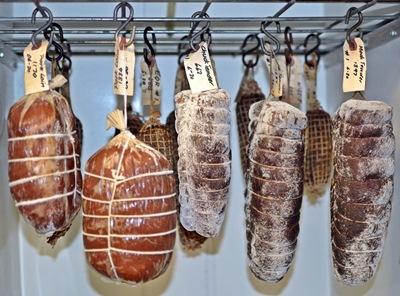[if gte mso 9]><xml> <o:DocumentProperties> <o:Author>Miroslaw Stanuszek</o:Author> <o:Version>9.2720</o:Version> </o:DocumentProperties></xml><![endif]
But my message is real important for so many devoted home cooks and apprentice meat cure experts - I have to do it!
How do you follow a fine recipe that you just discovered on the NET?
Here is an example:
1/2 slab of pork belly
1 3/4 cup salt
3 1/2 tablespoon of...
1 1/8 oz ...
1 heaping spoon of...
Would you please help me to convert this precious recipe to 1lb and 14oz of meat?
You can't? Don't worry, I can't do this either. And thousands others struggling too with this problem. And too many first timers quit this amazing hobby because their first attempt...
We all have at least one electronic scale at home (less than 20 dollars). Does your scale show cups, teaspoons or heaping tablespoons on it? hmmmm...
Most likely - it displays kilograms and grams (don't run away - it's decimal).
Please put your meat on the scale and read it: 1 kilogram equals 1000 grams - that's all!
Lets say your cut of meat weights 1450 grams (1.450 kilo gram - it's the same)
Here is your NEW recipe:
Ingredients PER KILOGRAM or Ingredients per 1000 grams of meat
32g kosher salt
3gr cure #1
14g sugar
3.5g black pepper
How much did you say is the weight of your meat? It is "1.45 kg"
OK - here is the solution:
32g kosher salt times 1.45 = 46.4g
3g cure #1 times 1.45 = 4.35g
14g sugar * 1.45 = 20.3g
3.5g black pepper * 1.45 = 5.0g
It's that simple - no more waste of time, money and fighting with divorce attorneys...
But how can you convert tablespoons or pounds to grams and kilograms?
It just takes a few minutes (well - maybe a bit longer...).
1 teaspoon = 5g
1 tablespoon = 15g
1cup = 236g
1oz = 28.3g
1lb = 454g
Dear old school experts - you do fine with your measurements, don't change it! (You're doing it just like my daddy, the finest butcher I've ever
know - no scale needed).
This article is indented as a support for the new generation; they're right on our back, ready to learn and take over "our" business... Good to have them with us!
Your PONGO
[if gte mso 9]><xml> <w:WordDocument> <w:View>Normal</w:View> <w:Zoom>0</w:Zoom> <w:DoNotOptimizeForBrowser/> </w:WordDocument></xml><![endif]
But my message is real important for so many devoted home cooks and apprentice meat cure experts - I have to do it!
How do you follow a fine recipe that you just discovered on the NET?
Here is an example:
1/2 slab of pork belly
1 3/4 cup salt
3 1/2 tablespoon of...
1 1/8 oz ...
1 heaping spoon of...
Would you please help me to convert this precious recipe to 1lb and 14oz of meat?
You can't? Don't worry, I can't do this either. And thousands others struggling too with this problem. And too many first timers quit this amazing hobby because their first attempt...
We all have at least one electronic scale at home (less than 20 dollars). Does your scale show cups, teaspoons or heaping tablespoons on it? hmmmm...
Most likely - it displays kilograms and grams (don't run away - it's decimal).
Please put your meat on the scale and read it: 1 kilogram equals 1000 grams - that's all!
Lets say your cut of meat weights 1450 grams (1.450 kilo gram - it's the same)
Here is your NEW recipe:
Ingredients PER KILOGRAM or Ingredients per 1000 grams of meat
32g kosher salt
3gr cure #1
14g sugar
3.5g black pepper
How much did you say is the weight of your meat? It is "1.45 kg"
OK - here is the solution:
32g kosher salt times 1.45 = 46.4g
3g cure #1 times 1.45 = 4.35g
14g sugar * 1.45 = 20.3g
3.5g black pepper * 1.45 = 5.0g
It's that simple - no more waste of time, money and fighting with divorce attorneys...
But how can you convert tablespoons or pounds to grams and kilograms?
It just takes a few minutes (well - maybe a bit longer...).
1 teaspoon = 5g
1 tablespoon = 15g
1cup = 236g
1oz = 28.3g
1lb = 454g
Dear old school experts - you do fine with your measurements, don't change it! (You're doing it just like my daddy, the finest butcher I've ever
know - no scale needed).
This article is indented as a support for the new generation; they're right on our back, ready to learn and take over "our" business... Good to have them with us!
Your PONGO
[if gte mso 9]><xml> <w:WordDocument> <w:View>Normal</w:View> <w:Zoom>0</w:Zoom> <w:DoNotOptimizeForBrowser/> </w:WordDocument></xml><![endif]
Last edited:







